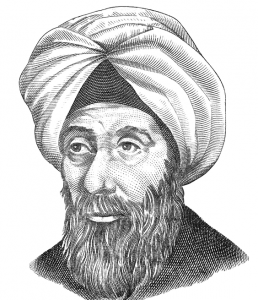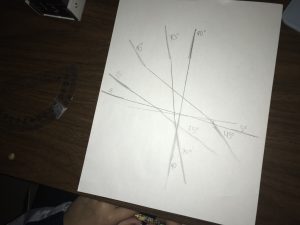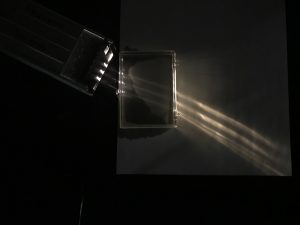Light: A Reflection, Not a Refraction
Ok so there are a million quotes floating around about light, darkness, and all that other philosophy stuff. They’re more metaphorical though, and the next unit in science class was not about an Confucius theory. Instead it was about the scientific properties of light, reflections, and a few labs.
Particles and Waves
To begin, our teacher Ms. Klausen asked us to prove that light moves in waves. The properties of of light are special in the way that they are both dually particles and waves. People in history have gone back and forth between theories, whether lights are particles or waves. Their studies and tests proved that one can explain some things but not others. Waves bounce and move
around, so to prove that light does the same Lucy, Anika and I used mirrors with flashlight. Shining the light at the right angle on one mirror made it shine onto another, showing that it moves in waves by bouncing off of reflective surfaces.
Islamic Additions to Light
The studies of light originated many, many years ago, before European questioning even began. Ibn al-Haytham was one of the first major contributors into discovering the science behind optics and light.
Included in his greatest work, Kitāb al-manāẓir (Book of Optics), he wrote about his theory of light. It correctly states that light reflects off of objects and we see those reflections. The explanation that most had at that time was that light was emitted through our eyes and onto objects. Ibn al-Haytham proved this theory by using a camera obscura, which uses a convex lens to project and image upside down. He also included in his book the first Ray diagram in history. In class we also used ray diagrams and light boxes to see what happens to light as it’s reflected at different angles or through different surfaces. Many other Islamic scholars greatly contributed to studies of light, and without them we would not know nearly as much about our eyes as we do today.
- Experimentations
Roles of Light on Earth
While doing this unit, Ms Klausen showed us a David Attenborough documentary which I now regard as one of the most amazing things I’ve ever seen. The program is named Life that Glows and in it contains so much incredible videography and knowledge all about organisms usage of light all around the world. Beginning with thousands of fireflies illuminating in the dark night sky, David talked about how these creatures use light to communicate.
It then went on to show some amazing videos and shots of dinoflagellates, tiny bacteria living in water. When anything around them moved, two chemicals in their bodies came together to light up. There was one shot in particular that took my breath away. In the Sea of Cortez, Mexico, dolphins slice through the water in amazing synchronicity. Surrounding them in the vast water were these bacteria, and as the dolphins danced, their forms were illuminated by these millions of tiny organisms. I highly suggest you watch it, as it was so incredible now one of my life’s goals is to see it for myself (though I don’t know how yet..). There were countless more creatures included in this detailed documentary, stretching from fish inhabiting the devoted of the ocean to termites in their giant mounds. The one thing they all used in a spectacular way was light. What I found so interesting is that us humans look at these creatures with a sense of wonder at their beauty, however for the animals themselves, their features helped them survive. Using light, they could see where they were going, use a code to talk to each other, or warn away predators by suddenly lighting up. The question that is still being answered is how these attributes came about, and why. I’m very excited to see that answered while continuing to admire these feats of nature.
Why do Humans Value Light
Now it’s time for cheesy quotes!
“In order for the light to shine so brightly, the darkness must be present” -Francis Bacon
Like this says, light can only be light because of darkness. Obviously that is a metaphor for bad times and good times, but as people we can appreciate light because of what it represents. Light in a far less physical sense means happiness , hope and goodness. There is a reason fairytales always have a fair princess and darkly cloaked hag. Little children want a nightlight because they are afraid of what may be in the dark, and that small light shows them what they want to see. Without light, not only would the human race be stumbling around aimlessly but nothing would exist. The sun gives plants life, and no plants means no animals and no animals or plants means no food and no food means nothing. Even the creatures who thrive in the depths of the ocean are alive because of other things receiving light. To say the world wouldn’t have anything without brightness would be an understatement. As I look around at the moment of writing this, I notice the rays of sun coming through my door and windows,
, hope and goodness. There is a reason fairytales always have a fair princess and darkly cloaked hag. Little children want a nightlight because they are afraid of what may be in the dark, and that small light shows them what they want to see. Without light, not only would the human race be stumbling around aimlessly but nothing would exist. The sun gives plants life, and no plants means no animals and no animals or plants means no food and no food means nothing. Even the creatures who thrive in the depths of the ocean are alive because of other things receiving light. To say the world wouldn’t have anything without brightness would be an understatement. As I look around at the moment of writing this, I notice the rays of sun coming through my door and windows,  onto everything and making it so I can see. Light is beyond valuable to everything on earth, and we must all make an effort to understand more about it, whether that be through Islamic scholars, or an interesting documentary.
onto everything and making it so I can see. Light is beyond valuable to everything on earth, and we must all make an effort to understand more about it, whether that be through Islamic scholars, or an interesting documentary.







